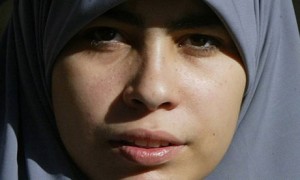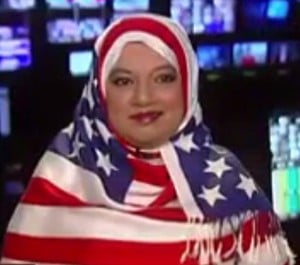Complete with your standard extreme close-up of a hijab-clad woman confusingly looking at the voyeuristic lens before her, the Guardian’s “Comment is Free” section recently featured a piece by writer Nadiya Takolia, entitled: “The Hijab has Liberated Me From Society’s Expectations of Women.”
Probably like many readers of this blog, my initial reaction consisted something of a suppressed cough-caught-in-a-groan. A cough because this topic and argument are so overdone and done in the same exact way everywhere and every single time; a groan because I knew CiF trolls would come out dressed to the nines in bigotry.

(And they did.)
Takolia’s piece resonates with a lot of young Muslim women, especially those who live in North America and wear hijab; she argues for the hijab beyond religious ethics and within the framework of feminist liberation and responding to socially-imposed exploits of the vain persuasion. As Takolia says it “not religion but politics” that drives, so to speak, her hijab:
“I do not believe that the hair in itself is that important; this is not about protection from men’s lusts. It is me telling the world that my femininity is not available for public consumption. I am taking control of it, and I don’t want to be part of a system that reduces and demeans women. Behind this exterior I am a person – and it is this person for which I want to be known.”
For many women, the adornment of the headscarf is the representation of the antithesis of female objectification and subjugation in a social sphere where the female body is, essentially, a capitalistic transaction. Women’s bodies and women’s bodies in sex are used to sell us – men and women – nearly everything, and this undoubtedly has an effect on how women engage with their own bodies and how men and women both engage with one another and in sexual affairs. The headscarf can then become a tool for fighting perceived gender oppression and social violence. This, of course, is not the case for all women who wear the hijab. For instance, for many other women the headscarf is a sign of piety, spiritual elevation and a great obedience to the Will of God. And for many other women still …the headscarf is far from a choice, or even a passing thought. And then there are all those women who find themselves shifting in between and far outside these three cookie-cutter categories of religious engagements I’ve laid out for unfortunate convenience.
The hijab, just as a headscarf and not as an internalized external practice in piety, is complicated not just for each and every different group of women but even for each and every individual woman. So, I’m not here to talk about that (shut up, I realize I kinda already did) really because I think this discussion can be endless and, quite honestly, futile. I think we need to move beyond that. But I also think it’s as important to challenge staple arguments for the headscarf as it is to challenge staple arguments that speak against it – primarily because oftentimes both of these arguments, however different in the details, are framed in the same way and are ultimately not all that different from one another save in their conclusions.
Takolia argues, in her piece, that through a series of growing experiences with socially-given vanity and body objectification, she was drawn towards the hijab. It was, for her, a political project to protest the sexualization and commercialization of her body, a woman’s body:
“From perfume and clothes ads to children’s dolls and X Factor finals, you don’t need to go far to see that the woman/sex combination is everywhere.”
While Takolia’s own journey to and experience with the hijab resonates profoundly with my own personal journey and experience (cue violins), I cannot help but urge that the Liberation trope needs dire re-examination.
A body clad in a headscarf is not a body liberated from social expectations and demands. From both within the Muslim community and from outside of it, women remain encumbered with pedestals for their looks, their personalities and their bodies. This isn’t a problem of religion; it is a problem of cultures and communities – often clashing. There are expectations for hijab-clad women, within many of the diverse North American Muslim communities, in how they handle themselves, how they interact with the opposite sex (if at all). Even their religiosity and level of religious knowledge are assumed. Women wearing hijab are no longer allowed to be humans prone to err, as God created us and as God acknowledges, but rather are expected to have achieved some sort of unwavering piety resulting from fabric choice. Instead, they can become objects for observance and representation; a sort of silent groups of members of a “clergy.” And these standards, of course, are not necessarily the same for women without hijab – as they are often already seen as “not quite there yet,” or outside the fold of physical, “tangible” piety. As I have written elsewhere, the hijab emphatically provides a privilege at the expense of Muslim women not wearing it:
“…since piety is paramount in Islam and since physical manifestations of piety are more than just paramount in many North American Muslim communities, does not the veiled group receive a privilege over the other young women particularly in their communities? Outside of the community, the situation is vastly different and reversed more often than not, but the issue of perceived piety persists which in turns gives veiled women a certain privilege within their respective communities over those who choose not to veil.”
In addition to this particularity of privilege, there is also the issue of hijabofashionistas. There is a growing culture of hijab fashion (makeup, clothing, hijab styling), both in the blogosphere and on the runways – how does this, in turn, fit in with our argument of the liberation theology of the hijab? If the hijab can be worn to “liberate” us from bodily expectations, can it not also become a part of that oppression itself? How do we then deal with the trope of scarf-clad liberation? The problem remains that we look solely to the hijab for “liberation,” not realizing that it is merely a part of a long journey through and towards the liberation of the self from the Self – our religion prescribes more ways for us to deal with the daily mirror battles – and the war with the muffin top jean effect and the livid horror of uneven skin tone – than by simply putting on a headscarf.
If we are to speak of the liberation of our bodies, egos, minds and hearts, then it is important for us to approach this liberation holistically. The verses in the Qur’an that are interpreted to support the covering of the hair and bosom do not exist in isolation. They were not revealed in and of themselves –they came within the context of an entire message interspersed with several messages, for both men and women, outlining a diverse ethical theory for social relations as well as for self-preservation. If we, as Muslims, depend on what we wear and do not wear for our “liberation” from self-consumption and objectification, then we risk becoming victims of those exact things.












